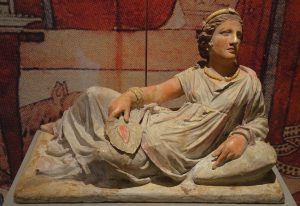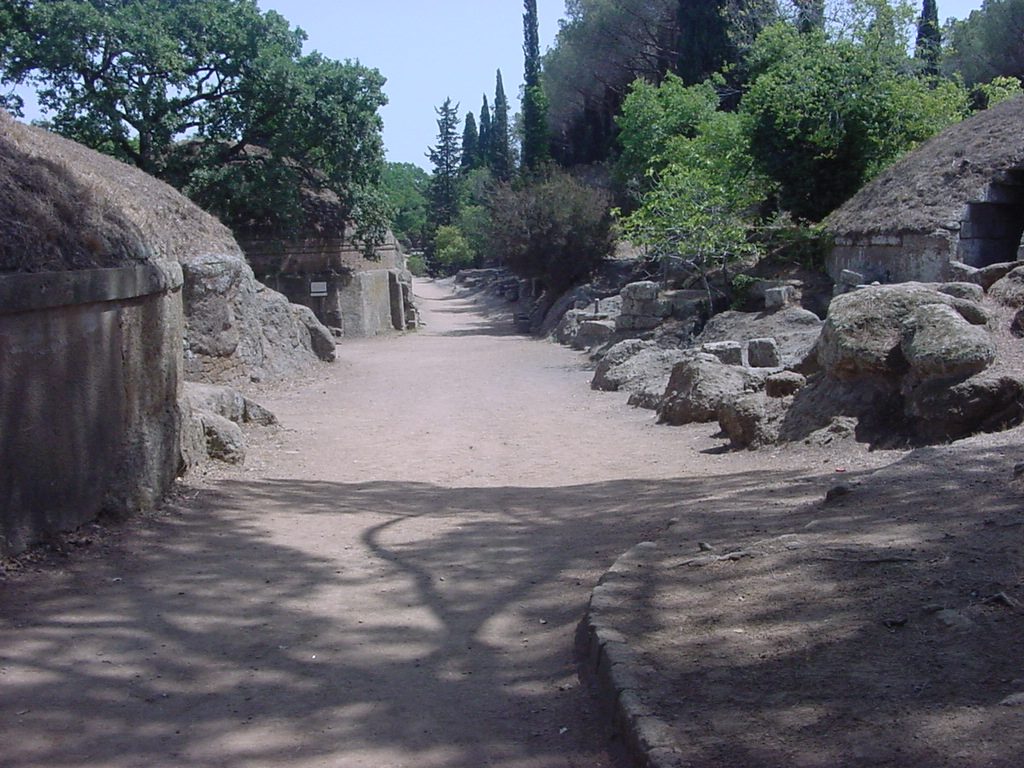My Starting Point
As usual, I look for images. I fond this one and love it. This piqued my interest and I began my preliminary internet research.

The description on Wikimedia Commons: “The dead woman, her name inscribed on the base of her chest, was clearly a well-to-do lady. She reclines upon a mattress and pillow, holding an open-lidded mirror in her left hand and raising her right hand to adjust her mantle. She wears a tunic (chiton) with high girdle and a bordered cloa, and her jewellery comprises a tiara, earrings, necklace, bracelets and finger-rings. The skeleton from the sarcophagus was found to belong to a woman who was about fifty years old at the time of her death.”
Another blogger, Dulcia, calls her clothing items something different; “Note the red clavi visible at the extreme shoulder edge of the woman’s vestis longa, and the red border on her palla (which looks like a toga but is worn like a palla).”
Next, I then found this image and was intent on developing this as my secondary persona for the hot and humid Gulf Coast summer.

Dulcia noted that this is a “Painted terracotta funerary urn lid of an Etruscan woman, from Chiusi, ca. 150-120 BC. Currently in the Badisches Landesmuseum Karlsruhe, Germany. The extant paint has been enhanced. Note the clavi on the woman’s vestis longa, and the red border on her palla.”
So this is a blogger labeling their clothing as Roman, or more specifically “Etrusco-Latin”. Some bloggers say the Etruscans are indigenous to the Italian Peninsula and others are writing that they emigrated. Are they considered Greco-Roman? Or Latin?
To drill down to the facts I have to take this very surface level search much deeper. I need to find reliable/ reputable sources. I turn to the Oxford Bibliographies website.
For most of the nine centuries prior to the Augustan settlement of Italy in 27 BCE, the Etruscans were the most significant indigenous inhabitants of the Italian peninsula. At its height, their civilization amounted to a great deal more than a pale reflection of the glory that was contemporary Greece, or an eccentric prelude to the grandeur that was destined to suffuse Republican and Imperial Rome. Treated in its own right and on its own terms, the archaeological, architectural, artistic, historical, linguistic, political, and religious record of the largely autonomous Etruscan cities is indispensable to the proper understanding of the whole pre-Roman Mediterranean. (Oxford Bibliographies)
I’m intrigued. Oxford suggests Haynes and Pallottino as sources. Another fellow Reenactor from Italy recommends Bonfante’s book Etruscan Dress. A quick Google search delivers another book by Bonfante. These will be my first four sources.
Recommended Reading
Bonfante, Larissa. 1975/2003. Etruscan Dress. Baltimore: Johns Hopkins University Press. Baltimore.
Bonfante, Larissa. 1986. Etruscan Life and Afterlife: A Handbook of Etruscan Studies. Detroit: Wayne State University Press.
Haynes, Sybille. 2000. Etruscan civilization: A cultural history. Los Angeles: J. Paul Getty Museum.
Pallottino, Massimo. 1975/1978. The Etruscans. Bloomington: Indiana University Press; Harmondsworth, UK: Penguin.
Immigrants or Indigenous?
In the meantime, I found another blog with nice images written by a history professor in Portland. I figured this information would be reliable but it appears at first read to contradict what Oxford reported above. So, were the Etruscans immigrants or indigenous?
Location and Language
These are the basics that I got from a quick Google search. Some of this is from Wikipedia, which is a great starting point but I must remind you, NEVER stop there. Look for endnotes and references on the Wikipedia page to find out if the information reported is true or false.
The ancient people of Etruria are labeled Etruscans, and their complex culture was centered on numerous city-states that rose during the Villanovan period in the ninth century BCE and were very powerful during the Orientalizing Archaic periods. The Etruscans were a dominant culture in Italy by 650 BCE.

There was a period between 600 BCE and 500 BCE, in which 12 Etruscan city-states formed a loose confederation known as the Etruscan League. Etruscan was the official language for meetings. When Etruria was conquered by the Roman Republic, Latin became the official language.
Cities of Erutria. Latin and Italian city-state names are given between parentheses:
- Arritim (Arretium, Arezzo)
- Caisra (Caere, Cerveteri)
- Clevsin (Clusium, Chiusi)
- Curtun (Cortonium, Cortona)
- Felathri (Volaterrae, Volterra)
- Fufluna (Populonium, Populonia)
- Parusia (Perusia, Perugia)
- Tarchna (Volscian Anxur) (Tarracina, Terracina)
- Tarchnal (Tarquinii, Tarquinia)
- Veii (Veii, Veio)
- Vetluna (Vetulonium, Vetulonia)
- Vipsul (Faesulae, Fiesole)
- Velch (Vulci, Volci)
- Velzna (Volsiniia, Volsinii)
A History Professor’s Take
The following was written by Karen Carr, Associate Professor Emerita, Department of History, Portland State University. Read article on her site here: https://quatr.us/romans/etruscans-history-italy.htm
Around 700 BC, the Bronze Age people we call the Villanovans started to get ideas from the Greeks and Phoenicians who were sailing around the Mediterranean. They started to do things the way the Greeks and the Carthaginians did them. Historians call these people the Etruscans (ee-TRUSS-kins).

People used to think that the Etruscans came from someplace in West Asia, because the Greek historian Herodotus tells a story about some people from West Asia, the Lydians, who might have been the Etruscans. He says that these people fell on hard times, and didn’t have enough to eat. Now these people loved to gamble with dice. So they decided to only eat on even days, and on the odd days they would gamble, to take their minds off how hungry they were! But the famine went on for years. Herodotus says that after a while these people decided that half of them should go look for a better place to live. He says these were the Etruscans, and they settled in Italy. But now most people think that the Etruscans always lived in Italy.
The Etruscans lived mainly in northern Italy. Because they were learning from the Greeks and the Carthaginians, they learned how to do a lot of things that the Latins living around Rome didn’t know how to do yet. The Etruscans built cities with stone walls. They built big stone temples and they put big statues in them. They dug canals and ditches to irrigate (bring water to) their fields. And they had organized governments with kings. They could read and write, and swim. Soon other people in Italy copied the Etruscan ways of doing things.
About the same time as the Etruscans, a lot of Greeks also came to make Greek colonies. At first they were probably mainly trading posts. But later Greek people settled down there and began farming. The Greeks settled in southern Italy, where they took over most of the Etruscan land there. They founded the city of Naples, which became an important port (and it still is today).

The Etruscans traded a great deal with the Greeks and with the Carthaginians and Phoenicians. Etruscan traders sent lumber, furs, and probably slaves to West Asia and to Africa. They bought jewelry, pepper, medicines, perfume, wine, and Greek vases. Most of the Greek vases we have in museums today were found in Italy, in the tombs of the Etruscans!
The city of Rome lay between the northern and southern parts of Italy where the Etruscans lived. Because it was a good place to cross the Tiber river, the Etruscans wanted to control it. For a while, Rome may have been under the rule of Etruscan kings. These kings, like other Etruscan kings, made people build strong stone walls and stone temples and canals for water.
Carr’s Further Reading & Bibliography
Vulca the Etruscan, by Roberta Angeletti (1999).
The Etruscans, by Don Nardo (2004).
Hands-On Ancient People, Volume 2: Art Activities about Minoans, Mycenaeans, Trojans, Ancient Greeks, Etruscans, and Romans, by Yvonne Merrill (2004).
The Etruscans, by Graeme Barker and Tom Rasmussen (2000).
The Beginnings of Rome: Italy and Rome from the Bronze Age to the Punic Wars (c. 1000-264 BC), by Tim Cornell (1995).
I will report back on further study 🙂